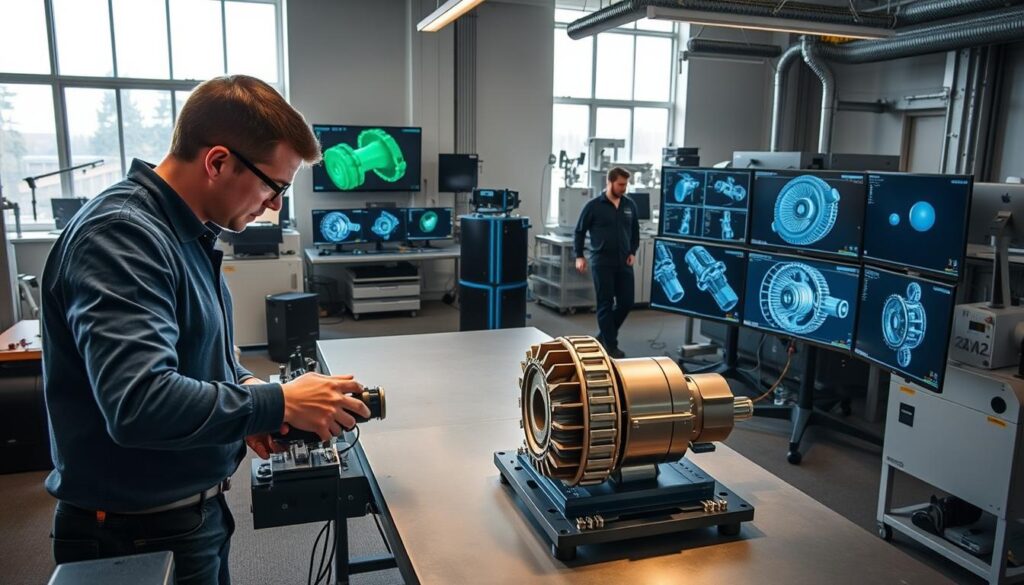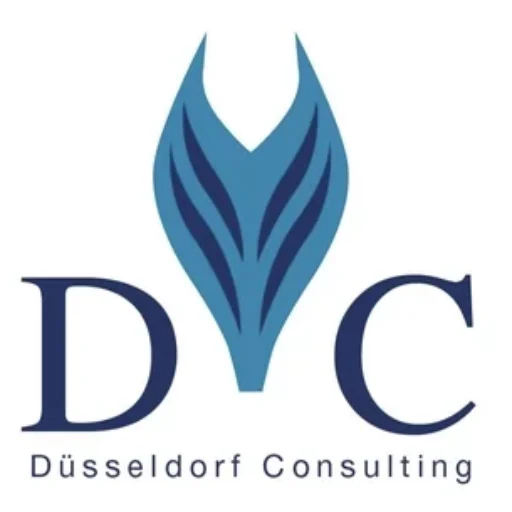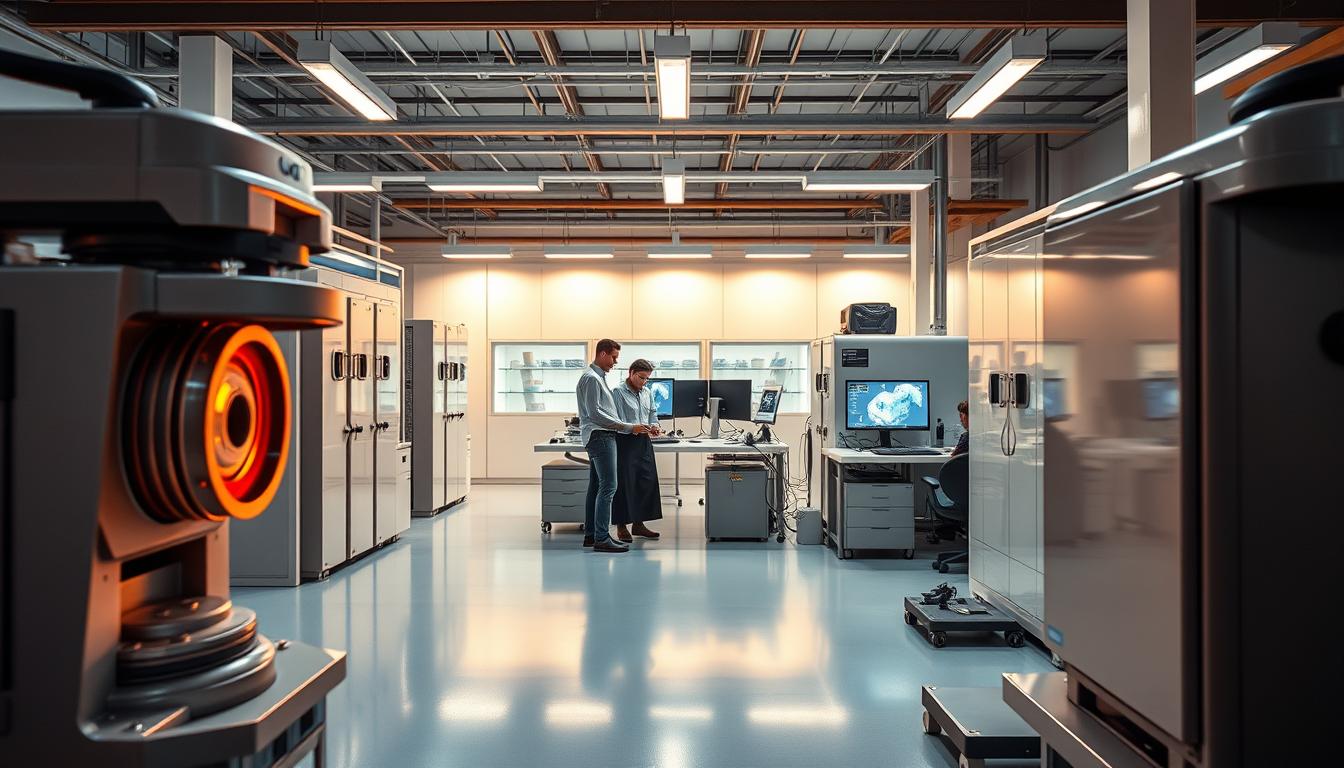Germany is at the forefront of technological advancements, and reverse engineering plays a crucial role in this landscape. The process involves detecting existing objects with high precision and converting them into digital models, enabling various industries to innovate and improve their products.
The significance of 3D scanning technology is evident in its applications across multiple sectors, including manufacturing, automotive, and aerospace. By leveraging the expertise of 3D scanning firms in Germany, companies can enhance their design and production capabilities, driving efficiency and competitiveness.
Key Takeaways
- Reverse engineering is crucial for technological advancements in Germany.
- 3D scanning technology has diverse applications across various industries.
- German firms are leveraging 3D scanning to improve design and production.
- The use of 3D scanning enhances efficiency and competitiveness.
- Reverse engineering and 3D scanning are key to innovation in Germany.
Understanding Reverse Engineering in Germany
Reverse engineering services are in high demand in Germany, driven by the need for product digitization and innovation. This process involves the detailed analysis and reproduction of components, which is crucial for quality assurance and the further development of technical components.
Definition and Importance
Reverse engineering is defined as the process of analyzing and reproducing existing products or components to understand their design, functionality, and manufacturing process. This technique is essential for innovation as it allows companies to improve existing products, reduce production costs, and enhance product performance.
The importance of reverse engineering lies in its ability to support the reproduction of complex components, facilitate quality control, and drive the development of new technologies. By leveraging reverse engineering, German companies can stay competitive in the global market, particularly in industries such as mechanical engineering and manufacturing.
Applications in Various Industries
Reverse engineering has diverse applications across various industries in Germany. In the automotive sector, it is used to improve vehicle components and enhance safety features. The aerospace industry benefits from reverse engineering by reproducing complex aircraft parts and improving their design.
In mechanical engineering and manufacturing, reverse engineering is utilized to optimize production processes and develop new products. Companies in these sectors rely on product digitization companies to convert physical products into digital models, facilitating analysis, modification, and reproduction.
The use of reverse engineering in Germany is not limited to these industries. It is also applied in other sectors where the analysis and reproduction of components are critical. By adopting reverse engineering techniques, companies can drive innovation, reduce costs, and improve product quality.
Overview of Industrial Scanning Technologies
With the advent of sophisticated scanning technologies, German industries are enhancing their capabilities in reverse engineering. Industrial scanning technologies have become a cornerstone in the country’s manufacturing and production sectors.
These technologies enable companies to create precise digital models of physical objects, facilitating accurate analysis and reproduction. The use of industrial scanning companies in Germany has seen a significant rise, driven by the demand for engineering measurement services that can deliver high precision.
Types of Scanning Technologies
There are several types of industrial scanning technologies available, each with its unique applications and benefits. Some of the most commonly used technologies include:
- 3D Laser Scanning: Known for its high accuracy and speed, 3D laser scanning is widely used in various industries, including construction, manufacturing, and heritage preservation.
- Structured Light Scanning: This technology is ideal for capturing detailed surface data and is often used in quality control and inspection.
- Computed Tomography (CT) Scanning: CT scanning is used for internal inspection and analysis, providing detailed cross-sectional images of objects.
Our state-of-the-art 3D laser scanners offer a point accuracy of up to 0.01 mm, making them invaluable tools for industrial scanning companies in Germany.
Key Benefits of Industrial Scanning
The key benefits of industrial scanning include enhanced precision, reduced production time, and the ability to inspect complex geometries. A comparison of the benefits of different scanning technologies is provided in the table below:
| Scanning Technology | Accuracy | Speed | Application |
|---|---|---|---|
| 3D Laser Scanning | High | Fast | Construction, Manufacturing |
| Structured Light Scanning | High | Medium | Quality Control, Inspection |
| CT Scanning | Very High | Slow | Internal Inspection, Analysis |
The use of engineering measurement services in conjunction with these technologies further enhances their capabilities, providing comprehensive solutions for industries in Germany.
Major Reverse Engineering Firms in Germany
Several leading reverse engineering firms are based in Germany, offering expertise that is crucial for industrial development. These companies are leveraging advanced technologies to provide innovative solutions across various sectors.
Leading Companies in the Field
Germany is home to a number of prominent reverse engineering firms, including Scanmotion, which offers 3D scanning services and reverse engineering solutions. These companies are equipped with state-of-the-art technology and a skilled workforce, enabling them to deliver high-quality services.
Some of the key services provided by these firms include:
- 3D scanning and modeling
- Reverse engineering and product design
- Prototyping and testing
Case Studies of Successful Projects
One notable example of a successful project is the collaboration between a German automotive manufacturer and a reverse engineering firm to redesign a critical component. Using advanced 3D scanning and reverse engineering techniques, the firm was able to create a more efficient and cost-effective solution.
Another case study involves a German aerospace company that utilized reverse engineering services to improve the design of a satellite component. The project resulted in significant enhancements to the component’s performance and reliability.
These case studies demonstrate the capabilities of German reverse engineering firms and highlight the impact of their work on various industries.
Industrial Scanning Companies in Germany
Industrial scanning companies in Germany are at the forefront of innovation, providing advanced laser scanning solutions that cater to the diverse needs of various industries.
The market for industrial scanning in Germany is robust, with several notable players offering a range of services including 3D scanning and reverse engineering solutions. These companies are pivotal in driving technological advancements across sectors.
Notable Players in the Market
Some of the prominent industrial scanning companies in Germany include those that specialize in high-precision scanning technologies. For instance, companies like Carl Zeiss and Hexagon are well-known for their advanced scanning solutions.
These companies offer a variety of services that are tailored to meet the specific needs of their clients, ranging from 3D modeling to quality control.

Services Offered by These Firms
The services provided by industrial scanning companies in Germany are diverse and include:
- 3D Scanning: Capturing detailed geometric data for various applications.
- Laser Scanning Solutions: Providing high-precision scanning for industries like manufacturing and construction.
- Reverse Engineering: Creating digital models from physical objects for analysis and reproduction.
These services are crucial for industries looking to adopt advanced technologies and improve their operational efficiency.
Key Industries Utilizing Reverse Engineering
The application of reverse engineering in Germany spans multiple key industries, transforming how products are designed and manufactured. This technology has become indispensable in driving innovation and improving product quality across various sectors.
Automotive Sector Innovations
In the automotive sector, reverse engineering is used extensively for component reproduction and quality assurance. By utilizing product modeling and analysis, manufacturers can recreate complex components with high precision, ensuring compatibility and performance. For instance, reverse engineering helps in creating detailed CAD models of existing parts, which can then be modified or improved upon.
The use of reverse engineering in the automotive industry also facilitates the development of more efficient and cost-effective manufacturing processes. It enables the analysis of competitor products, helping companies to identify areas for improvement and innovation.
Aerospace and Defense Applications
The aerospace and defense sectors in Germany also heavily rely on reverse engineering for various applications. Metrology services play a crucial role in ensuring the accuracy and reliability of components used in aircraft and defense systems. By employing advanced scanning technologies, companies can inspect and analyze parts to detect any deviations from specifications.
Reverse engineering in aerospace and defense not only enhances the quality of components but also contributes to the development of new technologies and systems. It allows for the recreation of obsolete parts, ensuring the continued operation of legacy systems.
Manufacturing and Production Enhancements
In the manufacturing sector, reverse engineering is used to improve production processes and product design. By analyzing existing products, manufacturers can identify opportunities for optimization, leading to reduced production costs and enhanced product functionality.
| Industry | Application of Reverse Engineering | Benefits |
|---|---|---|
| Automotive | Component reproduction, quality assurance | Improved product quality, cost reduction |
| Aerospace and Defense | Inspection and analysis of components | Enhanced accuracy, reliability, and technology development |
| Manufacturing | Process optimization, product design improvement | Reduced production costs, enhanced product functionality |
The table above illustrates the diverse applications and benefits of reverse engineering across key industries in Germany. By leveraging this technology, companies can achieve significant improvements in product quality, production efficiency, and innovation.
Regulatory Considerations for Reverse Engineering
The regulatory environment for reverse engineering in Germany is multifaceted, involving both legal aspects and intellectual property compliance. Reverse engineering firms must navigate these regulations to ensure they operate within the legal framework.
Legal Aspects of Reverse Engineering
Reverse engineering in Germany is subject to various legal requirements. Companies must comply with laws related to intellectual property, data protection, and competition. Intellectual property rights are particularly crucial, as they protect innovations and designs.
For instance, the German Patent Act (Patentgesetz) and the Utility Model Act (Gebrauchsmustergesetz) provide legal protection for inventions and utility models. Compliance with these laws is essential for reverse engineering firms to avoid legal repercussions.
| Legal Aspect | Description | Relevance to Reverse Engineering |
|---|---|---|
| Intellectual Property Rights | Protection of innovations and designs | High |
| Data Protection | Regulations on handling and storing data | Medium |
| Competition Law | Laws preventing anti-competitive practices | Medium |
Compliance with Intellectual Property Rights
Compliance with intellectual property rights is a critical aspect of reverse engineering in Germany. Firms must ensure that their practices do not infringe on existing patents, trademarks, or copyrights. This involves conducting thorough analyses and obtaining necessary permissions or licenses.
Product digitization companies in Germany often work closely with legal experts to ensure compliance with intellectual property laws. This collaboration helps in mitigating risks associated with potential legal disputes.
By understanding and adhering to regulatory considerations, reverse engineering and industrial scanning firms in Germany can operate effectively and maintain a competitive edge in the market.
The Role of Software in Reverse Engineering
Advanced software tools are essential for reverse engineering, allowing engineers to scan, model, and analyze complex geometries. These tools have revolutionized the field, enabling the creation of precise digital models from physical objects.
Popular Software Solutions Used
Several software solutions are widely used in the reverse engineering industry. NURBS (Non-uniform rational B-spline) is one such technology used for modeling and analyzing 3D scanned data. Other notable software includes Geomagic, PolyWorks, and CATIA.
These software solutions offer a range of functionalities, from data capture and processing to analysis and design. For instance, Geomagic is known for its ability to create accurate 3D models from scan data, while PolyWorks provides advanced inspection and analysis tools.
Comparisons of Software Capabilities
Different software solutions have varying capabilities, strengths, and limitations. The following table compares some of the key features of popular reverse engineering software:
| Software | Key Features | Strengths | Limitations |
|---|---|---|---|
| NURBS | Modeling and analysis of 3D scanned data | High accuracy, flexible modeling | Steep learning curve |
| Geomagic | 3D modeling from scan data | High precision, user-friendly interface | Resource-intensive |
| PolyWorks | Inspection and analysis tools | Advanced analysis capabilities, robust | Complex interface |
| CATIA | 3D design and modeling | Comprehensive design tools, industry-standard | High cost, complex functionality |
When selecting software for reverse engineering, firms in Germany, particularly 3D scanning firms, consider factors such as accuracy, ease of use, and compatibility with existing systems. Engineering measurement services also rely on these software solutions to deliver precise and reliable results.
The Future of Reverse Engineering in Germany
The landscape of reverse engineering in Germany is on the cusp of a revolution, driven by advancements in industrial scanning technologies. As the country continues to be at the forefront of industrial innovation, the demand for sophisticated reverse engineering services is expected to rise.

Emerging Trends and Technologies
Several emerging trends are set to shape the future of reverse engineering in Germany. One of the key developments is the integration of artificial intelligence (AI) and machine learning (ML) into reverse engineering processes. These technologies are enhancing the accuracy and efficiency of reverse engineering services.
Another significant trend is the adoption of 3D scanning technology, which is becoming increasingly sophisticated. This technology allows for the precise capture of complex geometries, facilitating the creation of accurate digital models.
Predictions for Industry Growth
The reverse engineering industry in Germany is poised for significant growth, driven by the increasing demand from various sectors, including automotive, aerospace, and manufacturing. Industrial scanning companies are expected to play a crucial role in this growth.
| Industry | 2023 | 2025 | 2030 |
|---|---|---|---|
| Automotive | 25% | 30% | 40% |
| Aerospace | 20% | 25% | 35% |
| Manufacturing | 15% | 20% | 30% |
As these industries continue to adopt reverse engineering services, the market is expected to expand, creating new opportunities for industrial scanning companies and other stakeholders.
Challenges Facing Reverse Engineering Firms
Reverse engineering firms in Germany face a myriad of technical and market-related obstacles. Despite the industry’s growth and technological advancements, companies must navigate complex challenges to remain competitive.
Technical Challenges in Implementation
The implementation of reverse engineering technologies, such as laser scanning solutions, poses significant technical challenges. These include the accuracy of scans, data processing complexities, and integration with existing systems.
Moreover, the need for high precision and the ability to handle complex geometries adds to the technical hurdles. Firms must invest in continuous training and upgrading their equipment to stay abreast of technological advancements.
Market Competition and Pricing Issues
The market for reverse engineering services in Germany is highly competitive, with numerous firms vying for projects. This competition often leads to pricing pressures, making it challenging for companies to maintain profitability without compromising on quality.
Additionally, the global nature of the industry means that German firms must compete with international companies, further complicating the market dynamics. To overcome these challenges, firms are focusing on niche areas and developing unique value propositions.
To address these challenges, German reverse engineering firms are adopting innovative strategies, including the adoption of advanced laser scanning technologies and collaborative partnerships. By leveraging these strategies, firms can enhance their capabilities and improve their competitive stance in the market.
Collaboration Opportunities in Industrial Scanning
Collaboration is becoming a key driver of innovation in Germany’s industrial scanning industry. As companies strive to improve their product modeling and analysis capabilities, the need for effective collaboration has never been more pronounced.
The trend towards collaboration is driven by the complexity of modern industrial projects, which often require a multifaceted approach to metrology services and product development. By partnering with other firms, companies can pool their resources and expertise, leading to more efficient and innovative solutions.
Partnerships Between Firms
Partnerships between firms in the industrial scanning sector can take many forms, from joint ventures to strategic alliances. These collaborations enable companies to share the costs and risks associated with large-scale projects, while also leveraging each other’s strengths in areas such as product modeling and analysis.
For instance, a company specializing in 3D scanning technology might partner with a firm that excels in data analysis software, creating a comprehensive solution that benefits both parties. Such partnerships not only enhance the capabilities of the involved companies but also drive innovation in the industry as a whole.
“The future of industrial scanning lies in collaboration. By working together, companies can achieve far more than they could alone.”
Opportunities for Research and Development
Collaboration also opens up new opportunities for research and development in industrial scanning. By working together, companies and research institutions can explore new technologies and methodologies, advancing the field and driving growth.
For example, a research project focused on improving metrology services through the use of advanced scanning technologies could involve collaboration between industry leaders, universities, and research institutes. Such projects not only contribute to the body of knowledge in the field but also help to develop the next generation of professionals.
| Collaboration Type | Benefits | Examples |
|---|---|---|
| Joint Ventures | Shared risk, combined expertise | Development of new scanning technologies |
| Strategic Alliances | Enhanced capabilities, improved efficiency | Integration of complementary technologies |
| Research Collaborations | Advancements in technology, talent development | Projects on advanced metrology services |
Training and Skills Development in the Industry
As industrial scanning companies in Germany continue to evolve, the demand for professionals with specialized skills is on the rise. The industry’s shift towards more advanced technologies necessitates a workforce that is not only skilled but also adaptable to new tools and methodologies.
Educational Programs and Certifications
To address the growing need for skilled professionals, various educational programs and certifications have been developed. These programs are designed to equip individuals with the necessary knowledge and skills to excel in the field of reverse engineering and industrial scanning.
- Certified 3D Scanning Technician programs
- Reverse Engineering and Design courses
- Industrial Scanning and Inspection training
These educational initiatives are crucial in ensuring that the workforce remains competent and competitive. According to industry experts, “the availability of specialized training programs is a key factor in the successful adoption of advanced technologies in the field.”
“The future of reverse engineering and industrial scanning in Germany depends heavily on our ability to develop and retain a skilled workforce.”
Importance of Skilled Workforce
A skilled workforce is the backbone of the reverse engineering and industrial scanning industry. Professionals with the right training and certifications are better equipped to handle complex projects, improve efficiency, and drive innovation.
| Skill | Importance | Industry Impact |
|---|---|---|
| 3D Scanning | High | Enables accurate data capture for reverse engineering |
| Reverse Engineering Software | High | Facilitates the design and modification of complex parts |
| Industrial Scanning Techniques | Medium | Improves inspection and quality control processes |
The importance of a skilled workforce cannot be overstated. As the industry continues to grow, the demand for professionals with specialized skills will only increase, making comprehensive training programs indispensable.
Conclusion: The Role of Reverse Engineering in Innovation
Reverse engineering and industrial scanning are pivotal in driving innovation across various industries in Germany. The country’s strong focus on technological advancement has led to the growth of numerous reverse engineering and industrial scanning firms.
Key Takeaways
The significance of reverse engineering lies in its ability to facilitate product digitization, enabling companies to analyze and improve existing products. Product digitization companies in Germany are leveraging this technology to provide innovative solutions.
Future Prospects
The future of reverse engineering and industrial scanning in Germany looks promising, with emerging trends and technologies expected to drive industry growth. As Reverse Engineering and Industrial Scanning Firms in Germany continue to evolve, they will play a crucial role in shaping the country’s industrial landscape.
By adopting cutting-edge technologies and fostering collaboration between firms, research institutions, and government organizations, Germany is poised to remain at the forefront of reverse engineering and industrial scanning innovation.
FAQ
What is reverse engineering, and how is it applied in Germany?
Reverse engineering is the process of analyzing and reconstructing a product or system to understand its design, functionality, and operation. In Germany, it is widely applied in various industries, including automotive, aerospace, and manufacturing, to improve product design, reduce production costs, and enhance overall efficiency.
What are the benefits of using 3D laser scanning in industrial applications?
3D laser scanning offers high accuracy and precision, enabling the creation of detailed digital models of complex objects and systems. Its benefits include improved product design, reduced prototyping costs, and enhanced quality control, making it a valuable tool in industries such as automotive, aerospace, and manufacturing.
How do German reverse engineering firms ensure compliance with intellectual property rights?
German reverse engineering firms adhere to strict guidelines and regulations to ensure compliance with intellectual property rights. They work closely with clients to understand their specific requirements and ensure that all projects are conducted within the bounds of relevant laws and regulations.
What role does software play in reverse engineering, and which solutions are commonly used?
Software plays a crucial role in reverse engineering, enabling the creation of digital models, analysis of product functionality, and simulation of performance. Commonly used software solutions include CAD software, 3D scanning software, and finite element analysis (FEA) tools, such as those offered by companies like Siemens and Autodesk.
What are the emerging trends and technologies in reverse engineering, and how will they impact the industry?
Emerging trends and technologies in reverse engineering include advancements in 3D scanning, artificial intelligence (AI), and machine learning (ML). These developments are expected to improve the accuracy and efficiency of reverse engineering processes, enabling the creation of more complex and sophisticated products, and driving industry growth.
What challenges do reverse engineering firms in Germany face, and how can they be overcome?
Reverse engineering firms in Germany face challenges such as technical complexity, market competition, and pricing pressures. To overcome these challenges, firms can invest in ongoing training and skills development, adopt new technologies, and focus on delivering high-quality services that meet the evolving needs of their clients.
How can collaboration between firms and research institutions benefit the reverse engineering industry?
Collaboration between firms and research institutions can drive innovation, improve processes, and enhance the overall competitiveness of the reverse engineering industry. By working together, firms and research institutions can develop new technologies, share knowledge, and address common challenges, ultimately benefiting the industry as a whole.
What is the importance of training and skills development in the reverse engineering and industrial scanning industry?
Training and skills development are essential in the reverse engineering and industrial scanning industry, as they enable professionals to stay up-to-date with the latest technologies and techniques. Educational programs and certifications, such as those offered by professional associations and industry organizations, play a critical role in ensuring that the workforce has the necessary skills to drive industry growth and innovation.
What is the future outlook for the reverse engineering industry in Germany?
The future outlook for the reverse engineering industry in Germany is positive, driven by advancements in technology, increasing demand for complex products, and the need for improved product design and functionality. As the industry continues to evolve, it is expected to play an increasingly important role in driving innovation and growth in various sectors.




